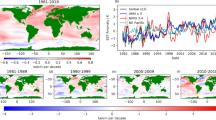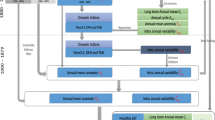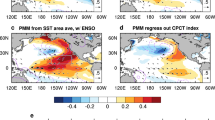Abstract
A PRINCIPAL component analysis (PCA) of mean sea level (MSL) pressure data for the North Atlantic–European sector of the Northern Hemisphere has revealed evidence of a solar-terrestrial relationship. The principal components represent independent atmospheric circulation anomaly patterns and the coefficients give the variation in time of the contribution of each anomaly pattern1,2. The data set described here comprises 101 winter MSL pressure anomalies (relative to the 1874 to 1974 winter average) on a 25-point, 20° longitude by 10° latitude grid covering the area 40°W–40°E, 30°N–70°N. Winters (December–February) are dated by the year of the January. The suitability of this grid for calibrating proxy data for the European sector is being investigated as a preliminary stage to the derivation of Holocene climatic information3. The data were obtained from the UK Meteorological Office, and are likely to contain in homogeneities due to different analysis techniques4 and so on. Some errors have become apparent in the course of the analysis and in general are confined to negligible low variance principal components. Missing data were replaced by the 101-yr mean for the grid point. Similar principal components were obtained by repeating the analysis for 30-yr sub-intervals. A slight latitudinal shift in the patterns occurred and there was some change in the relative importance of the principal components. Detailed results of the PCA are to be published elsewhere.
This is a preview of subscription content, access via your institution
Access options
Subscribe to this journal
Receive 51 print issues and online access
$199.00 per year
only $3.90 per issue
Buy this article
- Purchase on Springer Link
- Instant access to full article PDF
Prices may be subject to local taxes which are calculated during checkout
Similar content being viewed by others
References
Kutzbach, J. E. J. appl. Met. 6, 791–802 (1967).
Craddock, J. & Flood, C. Q. Jl R. met. Soc. 95, 576–593 (1969).
Kelly, P. M. Palaeogeog. Palaeoclim. Palaeoecol. (in the press).
Williams, J. & van Loon, H. Mon. Weath. Rev. 104, 1354–1361 (1976).
W.M.O. T.N. No. 79 Climatic Change (W.M.O., Geneva, 1966).
Schuurmans, C. J. E. Meded. Verh. K. ned. met. Inst. 92 (1969).
Sutcliffe, R. C. & Forsdyke, A. G. Q. Jl R. met. Soc. 76, 189–217 (1950).
Parker, B. N. Met. Mag. 105, 33–44 (1976).
Kelly, P. M. Phys. Bull. 27, 305–307 (1976).
Lamb, H. H. Climate Present, Past and Future 1 (Methuen, London, 1972).
Muir, M. S. Nature 266, 475–476 (1977).
Colebrook, J. M. Nature 263, 576–577 (1976).
Colebrook, J. M. Nature 266, 476 (1977).
Lamb, H. H. Phil Trans. R. Soc. 226, 425–533 (1970).
Author information
Authors and Affiliations
Rights and permissions
About this article
Cite this article
KELLY, P. Solar influence on North Atlantic mean sea level pressure. Nature 269, 320–322 (1977). https://doi.org/10.1038/269320a0
Received:
Accepted:
Published:
Issue Date:
DOI: https://doi.org/10.1038/269320a0
This article is cited by
-
New Metric for Minimum Variance Analysis Validation in the Study of Interplanetary Magnetic Clouds
Solar Physics (2020)
-
Sun’s total irradiance reconstruction based on multiple solar indices
Science China Physics, Mechanics and Astronomy (2012)
-
A quasi-biennial signal in western US hydroclimate and its global teleconnections
Climate Dynamics (2011)
-
Solar variability and the levels of Lake Victoria, East Africa, during the last millenium
Journal of Paleolimnology (2005)
-
Recent changes in the level of Lake Naivasha, Kenya, as an indicator of equatorial westerlies over East Africa
Climatic Change (1979)
Comments
By submitting a comment you agree to abide by our Terms and Community Guidelines. If you find something abusive or that does not comply with our terms or guidelines please flag it as inappropriate.



